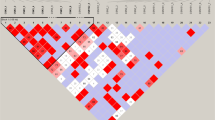Abstract
The purpose was to analyze the growth hormone GH1/GH2-N and GH2-Z gene copies and to assess their possible association with milk traits in Sarda sheep. Two hundred multiparous lactating ewes were monitored. The two gene copies were amplified separately and each was used as template for a nested PCR, to investigate single strand conformation polymorphism (SSCP) of the 5′UTR, exon-1, exon-5 and 3′UTR DNA regions. SSCP analysis revealed marked differences in the number of polymorphic patterns between the two genes. Sequencing revealed five nucleotide changes at the GH1/GH2-N gene. Five nucleotide changes occurred at the GH2-Z gene: one was located in exon-5 (c.556G > A) and resulted in a putative amino acid substitution G186S. All the nucleotide changes were copy-specific, except c.*30delT, which was common to both GH1/GH2-N and GH2-Z. Variability in the promoter regions of each gene might have consequences on the expression level, due to the involvement in potential transcription factor binding sites. Both gene copies influenced milk yield. A correlation with milk protein and casein content was also evidenced. These results may have implications that make them useful for future breeding strategies in dairy sheep breeding.




Similar content being viewed by others
References
Etherton TD, Bauman DE (1998) Biology of somatotropin in growth and lactation of domestic animals. Physiol Rev 78:745–761
Lagziel A, Lipkin E, Soller M (1996) Association between SSCP haplotypes at the bovine growth hormone gene and milk protein percentage. Genetics 142:945–951 (Corrigendum 1997 Genetics 146 442)
Dybus A, Grzesiak W, Szatkowska I, Błaszczyk P (2004) Association between the growth hormone combined genotypes and dairy traits in Polish Black-and-White cows. Anim Sci Pap Rep 22:185–194
Malveiro E, Pereira M, Marques PX, Santos IC, Belo C, Renaville R, Cravador A (2001) Polymorphisms at the five exons of the growth hormone gene in the algarvia goat: possible association with milk traits. Small Rumin Res 41:163–170
Marques PX, Pereira M, Marques MR, Santos IC, Belo CC, Renaville R, Cravador A (2003) Association of milk traits with SSCP polymorphisms at the growth hormone gene in the Serrana goat. Small Rumin Res 50:177–185
Marques MR, Santos IC, Carolino N, Belo CC, Renaville R, Cravador A (2006) Effects of genetic polymorphisms at the growth hormone gene on milk yield in Serra da Estrela sheep. J Dairy Res 73:394–405
Ofir R, Gootwine E (1997) Ovine growth hormone gene duplication-structural and evolutionary implications. Mammal Genome 8:770–772
Valinsky A, Shani M, Gootwine E (1990) Restriction fragment length polymorphism in sheep at the growth hormone locus is the result of variation in gene number. Anim Biotechnol 1:135–144
Gootwine E, Ofir YossefiS (1996) Characterization of PvuII polymorphisms between the ovine growth hormone GH2-N and GH2-Z gene copies. Anim Biotechnol 7:1–135
Lacroix MC, Devinoy E, Servely JL, Puissant C, Kann G (1996) Expression of the growth hormone gene in ovine placenta: detection and cellular localization of the protein. Endocrinology 137:4886–4892
IZS, Istituto Zooprofilattico Sperimentale dell’Abruzzo e del Molise “G. Caporale” (2008) Italian National Data Bank for the animal husbandry register, founded by the Ministry of Health. http://www.izs.it/IZS/Engine/RAServePG.php/P/256910010304/L/1. Last accessed 01 Mar 2011
Vacca GM, Carcangiu V, Dettori ML, Pazzola M, Mura MC, Luridiana S, Tilloca G (2008) Productive performance and meat quality of Mouflon × Sarda and Sarda × Sarda suckling lambs. Meat Sci 80:326–334
Hall TA (1999) BioEdit: a user-friendly biological sequence alignment editor and analysis program for Windows 95/98/NT. Nucl Acids Symp Ser 41:95–98
Yeh F, Yang RC, Boyle T (2000) Popgene V.1.32. Microsoft windows based freeware for population genetic analysis. http://www.ualberta.ca/~fyeh/popgene.pdf
Stephens M, Smith NJ, Donnelly P (2001) A new statistical method for haplotype reconstruction from population data. Am J Hum Genet 68:978–989
Thorpe DP, Holland B (2000) Some multiple comparison procedures for variances from non-normal populations. Comput Stat Data Anal 35:171–199
Kurpios NA, Sabolic NA, Shepherd TG, Fidalgo GM, Hassell JA (2003) Function of PEA3 Ets transcription factors in mammary gland development and oncogenesis. J Mammary Gland Biol Neoplasia 8:177–190
Li B, Wang X, Zhou F, Saunders NA, Frazer ICH, Zhao K-N (2008) Up-regulated expression of Sp1 protein coincident with a viral protein in human and mouse differentiating keratinocytes may act as a cell differentiation marker. Differentiation 76:1068–1080
Payne VA, Au W-S, Lowe CE, Rahman SM, Friedman JE, O’rahilly S, Rochford JJ (2009) C/EBP transcription factors regulate SREBP1c gene expression during adipogenesis. Biochem J 425:215–223
Rada-Iglesias A, Ameur A, Kapranov P, Enroth S, Komorowski J, Gingeras TR, Wadelius C (2008) Whole-genome maps of USF1 and USF2 binding and histone H3 acetylation reveal new aspects of promoter structure and candidate genes for common human disorders. Genome Res 18:380–392
Juárez-Aguilar E, Castro-Muñozledo F, Guerra-Rodríguez NE, Reséndez-Pérez D, Martínez-Rodríguez HG, Barrera-Saldaña HA, Kuri-Harcuch W (1999) Functional domains of human growth hormone necessary for the adipogenic activity of hGH/hPL chimeric molecules. J Cell Sci 112:3127–3135
Brunham LR, Singaraja RR, Pape TD, Kejariwal A, Thomas PD, Hayden MR (2005) Accurate prediction of the functional significance of single nucleotide polymorphisms and mutations in the ABCA1 gene. PLoS Genet 1:e83. doi:10.1371/journal.pgen.0010083
Adzhubei IA, Schmidt S, Peshkin L, Ramensky VE, Gerasimova A, Bork P, Kondrashov AS, Sunyaev SR (2010) A method and server for predicting damaging missense mutations. Nat Methods 7:248–249
Obenauer JC, Cantley LC, Yaffe MB (2003) Scansite 2.0: proteome-wide prediction of cell signaling interactions using short sequence motifs. Nucl Acids Res 31:3635–3641
Shimoni Y, Friedlander G, Hetzroni G, Niv G, Altuvia S, Biham O, Margalit H (2007) Regulation of gene expression by small non-coding RNAs: a quantitative view. Mol Syst Biol 3:138–146
Acknowledgments
Research supported by a grant from Regione Autonoma della Sardegna (L.R.7/2007).
Conflict of interest
The authors declare no conflict of interest.
Author information
Authors and Affiliations
Corresponding author
Rights and permissions
About this article
Cite this article
Vacca, G.M., Dettori, M.L., Balia, F. et al. Sequence polymorphisms at the growth hormone GH1/GH2-N and GH2-Z gene copies and their relationship with dairy traits in domestic sheep (Ovis aries). Mol Biol Rep 40, 5285–5294 (2013). https://doi.org/10.1007/s11033-013-2629-9
Received:
Accepted:
Published:
Issue Date:
DOI: https://doi.org/10.1007/s11033-013-2629-9



